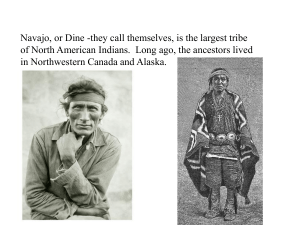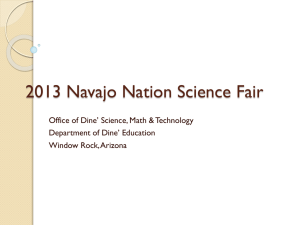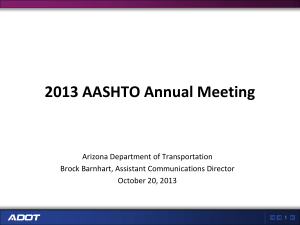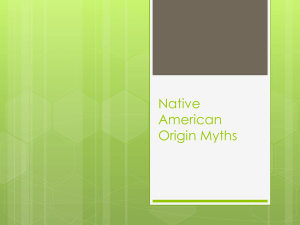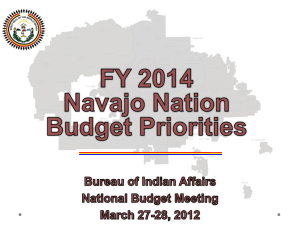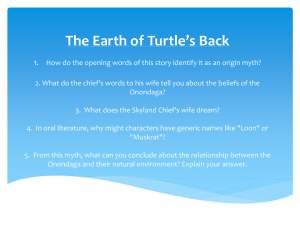Navajo Outline
advertisement
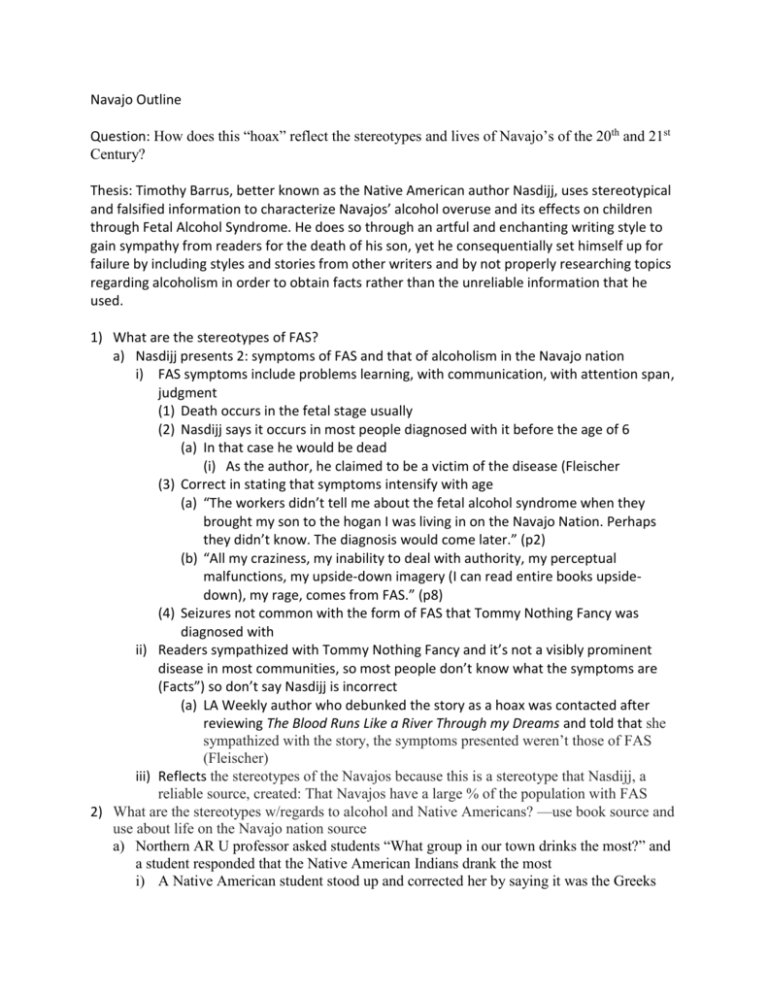
Navajo Outline Question: How does this “hoax” reflect the stereotypes and lives of Navajo’s of the 20th and 21st Century? Thesis: Timothy Barrus, better known as the Native American author Nasdijj, uses stereotypical and falsified information to characterize Navajos’ alcohol overuse and its effects on children through Fetal Alcohol Syndrome. He does so through an artful and enchanting writing style to gain sympathy from readers for the death of his son, yet he consequentially set himself up for failure by including styles and stories from other writers and by not properly researching topics regarding alcoholism in order to obtain facts rather than the unreliable information that he used. 1) What are the stereotypes of FAS? a) Nasdijj presents 2: symptoms of FAS and that of alcoholism in the Navajo nation i) FAS symptoms include problems learning, with communication, with attention span, judgment (1) Death occurs in the fetal stage usually (2) Nasdijj says it occurs in most people diagnosed with it before the age of 6 (a) In that case he would be dead (i) As the author, he claimed to be a victim of the disease (Fleischer (3) Correct in stating that symptoms intensify with age (a) “The workers didn’t tell me about the fetal alcohol syndrome when they brought my son to the hogan I was living in on the Navajo Nation. Perhaps they didn’t know. The diagnosis would come later.” (p2) (b) “All my craziness, my inability to deal with authority, my perceptual malfunctions, my upside-down imagery (I can read entire books upsidedown), my rage, comes from FAS.” (p8) (4) Seizures not common with the form of FAS that Tommy Nothing Fancy was diagnosed with ii) Readers sympathized with Tommy Nothing Fancy and it’s not a visibly prominent disease in most communities, so most people don’t know what the symptoms are (Facts”) so don’t say Nasdijj is incorrect (a) LA Weekly author who debunked the story as a hoax was contacted after reviewing The Blood Runs Like a River Through my Dreams and told that she sympathized with the story, the symptoms presented weren’t those of FAS (Fleischer) iii) Reflects the stereotypes of the Navajos because this is a stereotype that Nasdijj, a reliable source, created: That Navajos have a large % of the population with FAS 2) What are the stereotypes w/regards to alcohol and Native Americans? —use book source and use about life on the Navajo nation source a) Northern AR U professor asked students “What group in our town drinks the most?” and a student responded that the Native American Indians drank the most i) A Native American student stood up and corrected her by saying it was the Greeks b) c) d) e) (1) This misconception is said to derive from videos and movies (2) Indians who drink do so for reasons that are the same as other American groups: to relax and release inhibitions (a) Indians have more inhibitions usually because they must compensate for social isolated and being kicked out of their home in the 20th century— cultural symbols from the old home not present anywhere else (3) Many Indian reserves ban the consumption of alcohol so stereotype=not accurate (4) statistically it’s been shown that Indians have higher drop-out rates, depression rates, unemployment rates and this can lead to alcohol use, but not cause it Nasdijj says “All the old, vicious morality that accompanies the stereotypical image of the inebriated Indian rises to this issue the way a hungry salmon rises to a fly.” (p8) i) “old and vicious” refers to the reputation of alcoholism in association with Native Americans (1) began when the Europeans brought over spirits ii) “vicious morality” it’s a life that eats away at the soul and is pervaded by demons according to Nasdijj iii) acknowledges the stereotypes he’s bringing to life, but he says that he cannot let the problems that arise from alcoholism sit in the shadows any more, so must shine a light on the image iv) the stereotype applies to all Indians, as he says the inebriated Indian, not the Navajo v) hungry salmon will eat anything, including a fly that he must jump out of the water to attempt to catch; this is similar to the stereotype of inebriation because Alcohol consumption and sale not allowed on Navajo reservation i) Bootleggers often bring alcohol onto the reserves though—attributes to the stereotypical image because beer cans line the side of the highways (1) Costs too much to enforce (2) Leads to further social isolation because people don’t want to be associated with a group of drunks (“About”) (a) Minority groups in general, including Hispanics, blacks, Latinos, and Native Americans all are stereotyped as substance abusers due to the social factors as listed below (Caetano) (b) We obtain these pre-dispositions from secondary sources and stories, such as “Fire-water Myth” which says that binge drinking is something that’s inherently a part of their culture and they cannot control this part of them— it’s inevitable (c) Not only characterized by alcohol consumption, but excessive alcohol consumption (i) “Indian Way of Drinking” (Caetano 237) ii) Native Americans in general are not predisposed to alcohol intake, but it depends on the specific tribe (there are over 500 with over 200 languages amongst the minority group of Americans) (1) Some drink to reach alternative states of consciousness (perhaps escaping demons), others for spiritual ceremonies (Caetano) Many groups completely abstain from alcohol consumption The few that do engage in excessive intake tarnish the reputation of the whole f) Caentano’s article and scientific observations state that that aside from stories, such as the Fire-water Myth, there’s no evidence to state that Native Americans are more predisposed to excessive alcohol intake as a part of their personality i) We create predispositions from history and European traders (1) They drop out of school more often than other children from different parts of the country to help at home or because of discrimination in schools which also gets them a bad reputation social pressure depression drinking (“About”) 3) Inconsistencies and debunking a) Although Nasdijj pretended to come from a Navajo background, he didn’t so instead relied on the information presented by the media and other Native American writers: directly relied on stereotypes from the 20th and 21st centuries in order to write the essay i) Sherman Alexie, a famous Native American author read the essay and realized that his life was being described by Nasdijj, who had borrowed information from one of his own works (1) Alexie noticed other writers’ styles (prose poetry for example) present in the essay (2) LA Weekly writer Fleischer Pointed out that Nasdijj referred to his mother being a Navajo in three different ways: “with the Navajo,” sometimes she was “Navajo, or so she claimed,” and other times she was just “Navajo.” b) American’s demand for noncommercial and compassionate stories, the con market is also open i) If the stories aren’t sincere, and the “artists” are only in it for the money, they won’t go to the extent that they need to in order to obtain accurate information on topics that they think they know so much about (“Top”) 4) Artful style a) Nasdijj wrote with artful style of prose and poetry along with the tragic nature of his stories in order to attract readers’ attention i) “But as his successes and literary credentials grew in number, so did his skeptics — particularly from within the Native American community.” (Fleischer) ii) Timothy Barrus interpreted Native American writing styles as rhythmic and naturebased, just as tribes’ tales are written iii) The doubt came from the Indian nations because while yes, that’s how tales are told, that’s not how reflections and biographies are often written (1) The community is modernizing, and Nasdijj’s writing wasn’t replicative of that b) “It is a place where the sun glitters golden on the gravel of the river, and life with all its prowess, and its struggle, and its tenacity and its yielding, exists in a turbulent crescendo all around you as it rushes downstream, unhindered by the complicated likes of man.” i) Intrigues the reader with the beauty of how we imagine a Native American nation (1) The glittering sun gives the reader the ability to visualize (2) Gravel of the river to see the harshness of the lifestyle, the harshness that alcohol brings to the lives of the tribe that used to be softer and have lighter lives (3) Turbulent crescendo reveals the extremes present in communities because not everyone drinks but even those who don’t have alcohol problems have been affected by ups and downs in the community, ever yielding to different people at different times (4) Downstream…just like Nasdijj’s dreams (5) The uncomplicated likes of man refer to the reliance of man on alcohol that women do not have (a) Nasdijj states, “but men drink” (p7) (i) Example of why it appealed to audiences and was convincing—it presented the story with brutal honestly: men can drink because it won’t damage the fetus, which is why women can’t (“Nasdijj” ii) Poetic style of writing intrigues readers of all backgrounds, which is why so many awards were won—it’s “Esquire’s Cinderella story as state by Sean Elder (1) won awards because Esquire had never published an American Indian story before because concerned with racism but this was especially moving + tragic (Fleischer) iii) intriguing to some Native Americans who didn’t see this as a hoax because it brought an encouraging message to those with similar experiences (1) children with FAS are told by Nasdijj that they’re not alone (2) “Because the silence is so ill fitting when it comes to FAS and the fact that so many Indian children have this horrible affliction must be articulated.” (Moore) (a) still relies on the stereotype of alcohol abuse among tribes 5) The title: The Blood Runs Like A River Through My Dreams (1) a) Personal interpretation based off of stereotypes: Nasdijj, as a Native American author used the reference to blood to refer to religious ceremonies involving hunting and animal rituals i) River refers to the habitat of many Indian nations and tribes ii) Dreams have spiritual and deeper meanings in Navajo culture than to everyday society iii) In regards to alcohol, alcoholism and FAS is like a downstream riverbegins to flow faster and is harder to stop. b) Moore: “He spilled his blood that runs like a river though his dreams…. spilled it all over the pages of this book so others might relate” i) Moore looked at the story as factual: he was convinced that others could relate because of the intensity and sensitivity of FAS ii) Hoax of a hoax iii) Assumes that so many Native American Indian children are affected (1) Stereotype of alcohol abusive mothers in order to draw the conclusion that many children are affected by FAS
